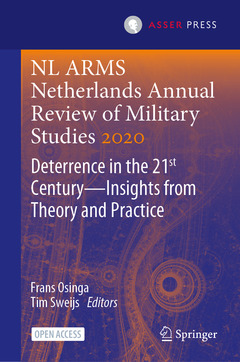NL ARMS Netherlands Annual Review of Military Studies 2020, 1st ed. 2021 Deterrence in the 21st Century—Insights from Theory and Practice NL ARMS Series

Chapter 1. Introduction.- Part I. Concepts of Deterrence (Evolution, Rediscovery, Conventional, Nuclear, Cross-domain).- Chapter 2. Understanding Deterrence.- Chapter 3. Deterrence Rediscovered: NATO and Russia.- Chapter 4. The Continuing Relevance of Conventional Deterrence.- Chapter 5. Nuclear Deterrence: A Guarantee for or Threat to Strategic Stability?.- Chapter 6. The US and Extended Deterrence.- Chapter 7. Deterrence by Punishment or Denial: The EFP Case.- Chapter 8. The Essence of Cross-domain Deterrence.- Part II. Non-Western Concepts of Deterrence.- Chapter 9. Deterrence à la Ruse: Its Uniqueness, Sources and Implications.- Chapter 10. An Overview of Chinese Thinking about Characteristics of Deterrence.- Chapter 11. Japanese Concepts of Deterrence.- Chapter 12. Deterrence (In)stability between India and Pakistan.- Chapter 13. Iran’s Syria Strategy.- Chapter 14. The Evolution of Deterrence.- Part III. Deterrence of Non-State Actors.- Chapter 15. Deterring Violent Non-State Actors.- Chapter 16. All Deterrence is Local: The Utility and Application of Localised Deterrence in Counterinsurgency.- Chapter 17. “This has triggered a civil war”: Russian Deterrence of Democratic Revolts.- Chapter 18. Deterrence in Peace Operations.- Part IV.- New Instruments and Domains of Deterrence.- Chapter 19. Sanctions and Deterrence: Targeted Sanctions.- Chapter 20. Deterrence, Resilience and the Shooting Down of Flight MH17.- Chapter 21. Cyber Deterrence: The Past, Present, and Future.- Chapter 22. New Technologies and Deterrence: Artificial Intelligence and Adversarial Behaviour.- Part V Rationality, Psychology and Emotions.- Chapter 23. Nuclear Deterrence in the Algorithmic Age: Game Theory Revisited.- Chapter 24. What’s on the Human Mind? Decision Theory and Deterrence.- Chapter 25. Deterrence: A Continuation of Emotional Life with the Admixture of Violent Means.- Chapter 26. The Missing Component in Deterrence Theory: The Legal Framework.- Conclusion: Insights from Theory and Practice.
Offers an exploration of emerging challenges for deterrence strategies
Presents studies on non-Western concepts of deterrence (e.g., China, Iran, Israel, Japan, Russia)
Demonstrates the application of deterrence concepts in new strategic contexts
Provides an assessment of impact of new technologies such as AI and cyber for deterrence theory
Includes the fifth wave deterrence theory
Provides insights for theory and practice
Offers an examination of cross-domain deterrence
This book is open access, which means that you have free and unlimited access
Date de parution : 12-2020
Ouvrage de 530 p.
15.5x23.5 cm



